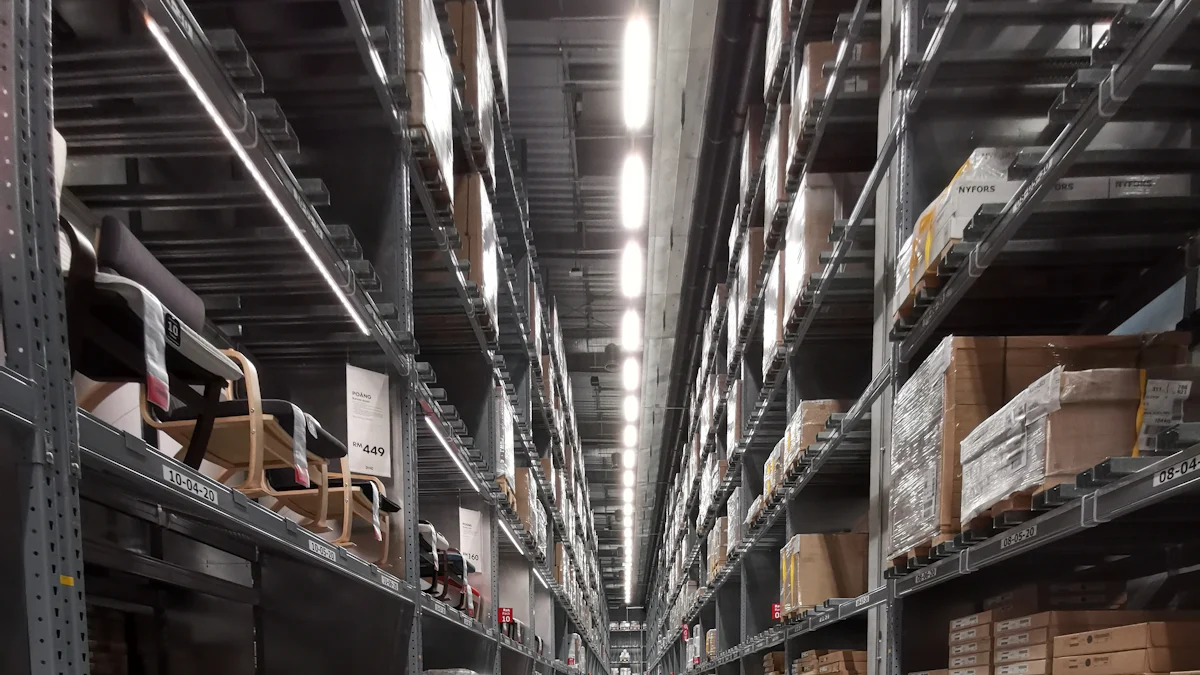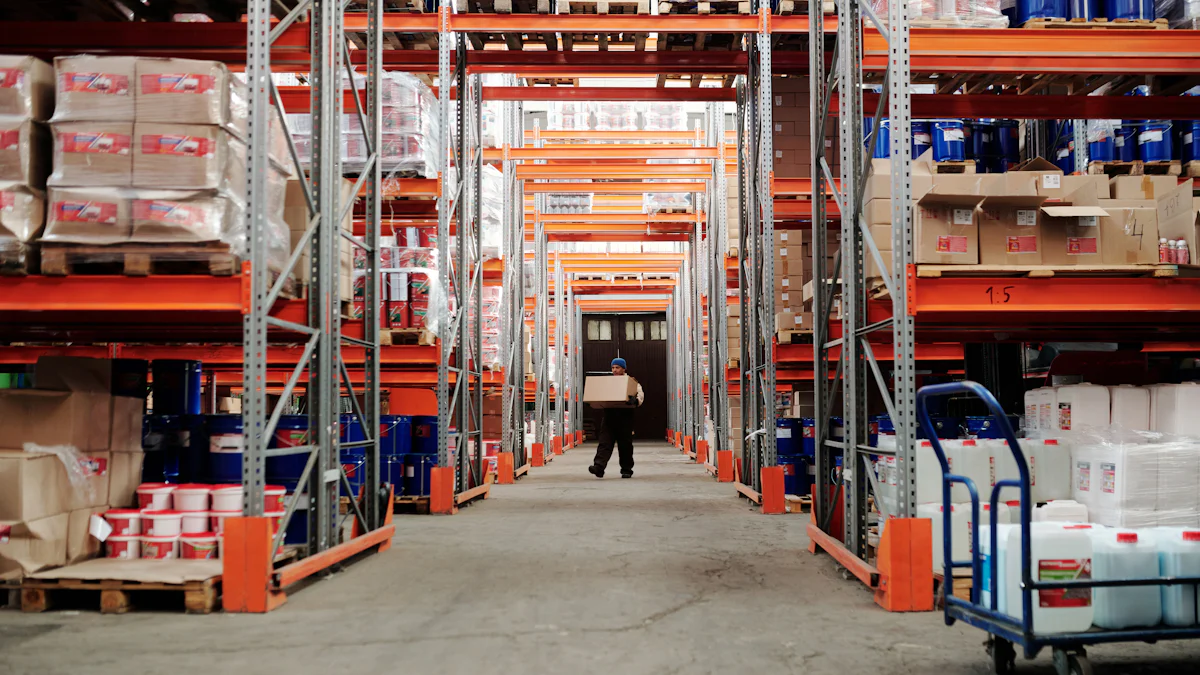


Warehouse management systems play a crucial role in modern logistics. Efficient warehouse operations ensure smooth supply chain processes. A Warehouse Control System optimizes automated equipment and systems in warehouses. This software enhances productivity by 25% and reduces space consumption by 20%. Inventory accuracy improves significantly, leading to better stock efficiency. The system manages material handling through subsystems like conveyor belts and Automated Storage and Retrieval Systems. Warehouse Control Systems increase operational efficiency and reduce human errors, ensuring safer and more effective warehouse environments.
Understanding Warehouse Control System

Definition of Warehouse Control System
A Warehouse Control System (WCS) manages real-time activities within warehouses. This system coordinates the flow of materials and information. WCS ensures efficient operations by integrating various equipment and subsystems.
Key components of Warehouse Control System
Key components of a WCS include:
- MHE Integration: Manages material handling equipment.
- Order Fulfillment Management: Oversees order processing.
- Inventory Management: Tracks inventory levels.
- Labor Management: Optimizes workforce deployment.
- System Integration: Connects with other systems for seamless operations.
- Task Scheduling and Dispatching: Allocates tasks efficiently.
- Reporting and Analytics: Provides insights into performance metrics.
How WCS differs from Warehouse Management Systems (WMS)
A Warehouse Control System focuses on real-time control of equipment. In contrast, a Warehouse Management System (WMS) handles higher-level planning and coordination. WCS interacts directly with machinery, while WMS manages broader warehouse functions.
Core functionalities of Warehouse Control System
A Warehouse Control System offers several core functionalities that enhance warehouse operations.
Real-time data processing
WCS processes data in real time to provide immediate updates. This capability allows managers to monitor inventory levels and order statuses. Real-time insights help in identifying issues quickly and taking corrective actions.
Equipment control and automation
WCS controls automated equipment like conveyors and retrieval systems. This control optimizes the movement of goods and ensures smooth material flow. Automation reduces human errors and increases operational efficiency.
Importance of Warehouse Control System
Enhancing operational efficiency
A Warehouse Control System significantly enhances operational efficiency in warehouses. The system identifies bottlenecks and optimizes workflows. Managers can dynamically adjust task priorities based on real-time data. This leads to improved coordination of material handling equipment.
Streamlining warehouse processes
Warehouse processes become streamlined with the implementation of a Warehouse Control System. The system provides real-time monitoring and data-driven insights. These insights allow for efficient material flow and reduced time in moving products. Increased productivity and faster order fulfillment result from these improvements.
Reducing operational costs
Operational costs see a reduction through the use of a Warehouse Control System. The system optimizes material flow and reduces labor costs. Efficient use of material handling equipment minimizes errors and product damage. This leads to improved profitability and a sustainable business model.
Improving accuracy and reliability
A Warehouse Control System improves accuracy and reliability within warehouse operations. The system offers valuable insights into warehouse activities. Data-driven decision-making becomes possible, enhancing overall efficiency.
Minimizing human errors
Human errors decrease with the help of a Warehouse Control System. Automation of tasks reduces the need for manual intervention. This ensures that processes run smoothly and accurately. The risk of errors and product damage is minimized.
Ensuring inventory accuracy
Inventory accuracy improves with the implementation of a Warehouse Control System. Real-time tracking allows for precise inventory management. Managers can ensure that stock levels are accurate and up-to-date. This leads to better stock replenishment and customer satisfaction.
Benefits of Implementing Warehouse Control System

Increased productivity
A Warehouse Control System boosts productivity in warehouses. The system streamlines operations and enhances workflow efficiency. Managers can allocate resources more effectively, leading to significant improvements.
Faster order fulfillment
Warehouse Control Systems enable quicker order processing. Automated systems manage tasks with precision and speed. This reduces the time needed to fulfill customer orders. Businesses experience increased customer satisfaction due to timely deliveries.
Optimized resource utilization
Resource utilization improves with a Warehouse Control System. The system allocates labor and equipment based on real-time data. This ensures optimal use of available resources. Companies benefit from reduced waste and increased operational efficiency.
Better inventory management
Warehouse Control Systems enhance inventory management capabilities. Real-time monitoring provides accurate insights into stock levels. This leads to better decision-making and inventory control.
Real-time inventory tracking
Real-time tracking is a key feature of Warehouse Control Systems. Managers receive instant updates on inventory status. This allows for immediate action on discrepancies or shortages. Businesses maintain accurate stock levels and avoid overstocking or stockouts.
Improved stock replenishment
Stock replenishment processes improve with a Warehouse Control System. The system predicts demand patterns using historical data. This ensures timely restocking of inventory. Companies maintain optimal stock levels and reduce carrying costs.
Challenges in Implementing Warehouse Control System
Integration with existing systems
Integration of a Warehouse Control System with existing systems presents significant challenges. Compatibility issues often arise due to differences in software architecture. Many warehouses use legacy systems that may not align with modern WCS technology. This misalignment can lead to inefficiencies and operational disruptions.
Data migration challenges also complicate the integration process. Transferring data from old systems to a new WCS requires precision. Errors during migration can result in data loss or inaccuracies. Ensuring data integrity is crucial for maintaining warehouse operations.
Cost considerations
Cost considerations play a vital role in the implementation of a Warehouse Control System. The initial investment can be substantial. Businesses need to purchase software licenses and hardware components. Installation and configuration require additional financial resources.
Ongoing maintenance costs add to the financial burden. Regular updates and technical support are necessary for optimal performance. These costs must be factored into the overall budget. Proper financial planning ensures the sustainability of the WCS.
Comparing Warehouse Control System with Other Systems
WCS vs. Warehouse Management Systems (WMS)
Functional differences
A Warehouse Control System (WCS) focuses on real-time control and optimization of Material Handling Equipment (MHE). This system ensures smooth operation of automated machinery. A Warehouse Management System (WMS) operates at a broader level. WMS handles inventory management and overall warehouse planning. WCS provides immediate control, while WMS manages strategic functions.
Use case scenarios
WCS suits environments with high automation needs. Facilities with complex material handling equipment benefit from WCS. Real-time control enhances efficiency in such settings. WMS fits broader operational requirements. Warehouses needing comprehensive inventory oversight use WMS. Strategic planning and coordination are key features of WMS.
WCS vs. Enterprise Resource Planning (ERP) systems
Scope and scale
WCS has a narrower scope compared to ERP systems. WCS focuses on real-time operations within warehouses. ERP systems cover a wide range of business processes. These include finance, human resources, and supply chain management. WCS optimizes specific warehouse tasks. ERP systems integrate various organizational functions.
Integration capabilities
WCS integrates with automated equipment for seamless operations. This integration ensures efficient material flow. ERP systems connect different business departments. Integration across multiple functions is a hallmark of ERP. WCS enhances warehouse efficiency. ERP provides a holistic view of business operations.
Implementation Strategies for Warehouse Control System
Assessing warehouse needs
A comprehensive assessment of warehouse needs forms the foundation of a successful Warehouse Control System implementation. Each warehouse has unique requirements that demand careful evaluation.
Identifying operational bottlenecks
Operational bottlenecks hinder warehouse efficiency. Managers must identify these bottlenecks to streamline processes. Common bottlenecks include slow material handling and inefficient task allocation. Addressing these issues enhances workflow and productivity.
Setting clear objectives
Clear objectives guide the implementation process. Objectives should align with overall business goals. Managers must define specific targets for efficiency improvements. These targets provide a roadmap for system deployment and performance evaluation.
Selecting the right Warehouse Control System
Selecting an appropriate Warehouse Control System involves careful consideration of various factors. The chosen system must meet the specific needs of the warehouse.
Evaluating vendor options
Vendor evaluation is crucial in selecting a Warehouse Control System. Managers should consider vendors with a proven track record. Key factors include system reliability, customer support, and industry expertise. A thorough evaluation ensures a suitable partnership for long-term success.
Customization and scalability
Customization and scalability are vital for a Warehouse Control System. Each warehouse requires tailored solutions to meet its unique demands. The system should offer customization options for specific workflows. Scalability ensures that the system can grow with the business. This flexibility supports future expansion and evolving operational needs.
Future Trends in Warehouse Control System
Technological advancements
AI and machine learning integration
Artificial intelligence and machine learning transform warehouse operations. These technologies enhance decision-making by analyzing vast amounts of data. Machine learning algorithms predict demand patterns, optimizing inventory management. AI-driven systems automate routine tasks, increasing efficiency and reducing errors. Integration with AI ensures that warehouses operate at peak performance.
IoT and smart warehousing
The Internet of Things (IoT) revolutionizes warehouse management. IoT devices provide real-time data on equipment and inventory. Sensors monitor conditions, ensuring optimal storage environments. Smart warehousing uses IoT to automate processes, improving accuracy and speed. Connectivity between devices streamlines operations, enhancing overall productivity.
Evolving industry demands
Rise of e-commerce
E-commerce growth drives changes in warehouse operations. Online shopping increases the need for efficient order fulfillment. Warehouses must adapt to handle higher volumes of smaller orders. Automation and advanced systems meet these demands, ensuring timely deliveries. The rise of e-commerce requires warehouses to become more agile and responsive.
Demand for faster delivery
Consumers expect rapid delivery times. This demand pressures warehouses to optimize processes. Efficient material handling systems reduce processing times. Real-time tracking provides visibility into order status, ensuring prompt delivery. Meeting delivery expectations enhances customer satisfaction and competitiveness.
The Warehouse Control System enhances warehouse efficiency by optimizing automated equipment operations. This system integrates advanced technologies like AI and machine learning, leading to improved decision-making for managers. The future of warehouse management will likely see increased reliance on such systems. As warehouses become more automated, the need for efficient control and coordination grows. Implementing a Warehouse Control System can significantly boost operational efficiency and accuracy. Businesses should consider adopting this technology to stay competitive and meet evolving industry demands.
FAQ
A Warehouse Control System (WCS) is software that manages real-time activities in warehouses. The system coordinates material handling equipment like conveyors and automated storage systems. WCS ensures efficient product flow and optimizes warehouse operations.
A WCS increases productivity by 25%. The system automates tasks and reduces manual intervention. Real-time data processing allows quick decision-making. This leads to faster order fulfillment and optimized resource use.
Implementing a WCS reduces space consumption by 20%. The system minimizes errors and product damage. Businesses experience improved stock efficiency and reduced operational costs. These factors contribute to a positive return on investment.
A WCS provides real-time inventory tracking. Managers receive instant updates on stock levels. This ensures accurate inventory management and timely replenishment. Improved accuracy leads to better customer satisfaction.
Integration with existing systems can present challenges. Compatibility issues may occur with legacy systems. Data migration requires precision to avoid inaccuracies. Initial investment and ongoing maintenance costs also need consideration.
Continue Reading About Warehouse Control System
2025 Best Data Integration Solutions and Selection Guide
Explore top data integration solutions for 2025, enhancing data management and operational efficiency with leading platforms like Fivetran and Talend.
Howard
Dec 19, 2024
Best Data Integration Platforms to Use in 2025
Explore the best data integration platforms for 2025, including cloud-based, on-premises, and hybrid solutions. Learn about key features, benefits, and top players.
Howard
Jun 20, 2024
Best Data Integration Vendors for Seamless Workflows
Discover the top 20 data integration vendors of 2025 for seamless workflows. Compare tools like Talend, AWS Glue, and Fivetran to optimize your data processes.
Howard
Jan 22, 2025
Customer Data Integration: A Comprehensive Guide
Master customer data integration to enhance business operations by combining data from multiple sources for a comprehensive customer view.
Howard
Sep 07, 2024
Enterprise Data Integration: A Comprehensive Guide
Explore enterprise data integration with this comprehensive guide. Learn the benefits of enterprise data integration and the best practices.
Howard
Jul 10, 2024
Exploring SAP Data Integration Tools and Their Functions
Explore SAP Data Integration tools like SAP Data Services, SAP HANA Smart Data Integration, and SAP Cloud Platform Integration.
Howard
Aug 12, 2024


